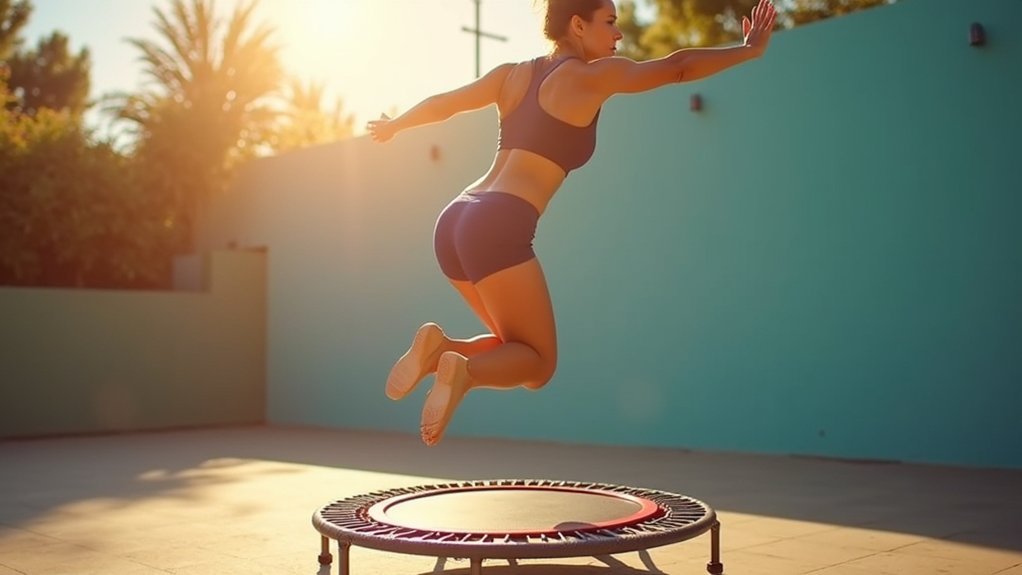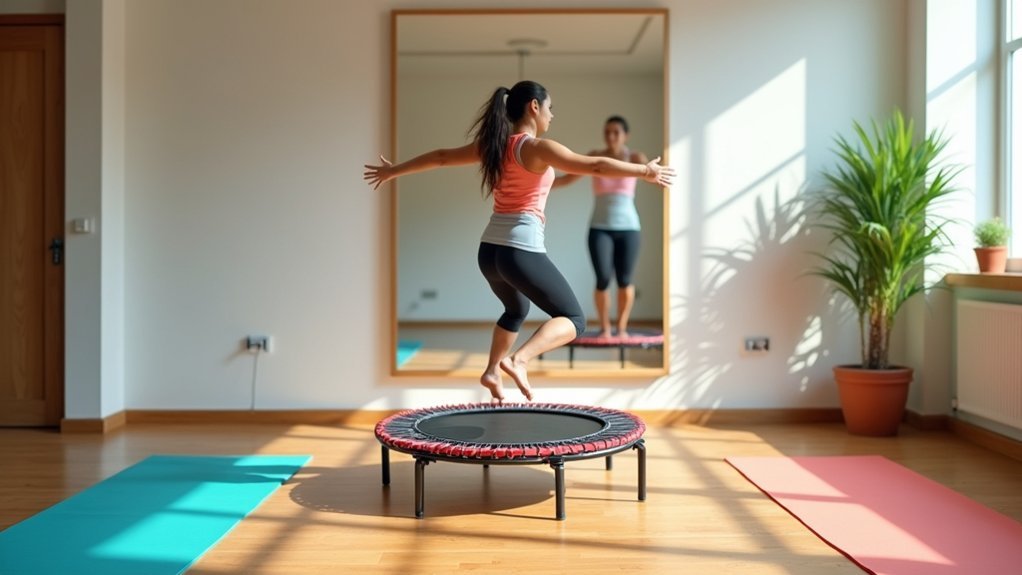Mini-trampoline workouts effectively strengthen your back by engaging multiple muscle groups through dynamic, low-impact movements. The unstable surface activates deep stabilizer muscles, enhancing posture and spinal alignment while building definition. Focus on maintaining a neutral spine, soft knee bends, and core engagement during exercises like pike jumps and torso twists. Add resistance bands or light weights for progression. Incorporate rebounding 2-3 times weekly for noticeable improvements in back strength and definition. The following routine will transform your posterior chain completely.
The Science Behind Trampoline Training for Back Muscles

While traditional back exercises often focus on isolating muscles through static movements, trampoline training offers a unique approach by creating dynamic neuromuscular challenges.
When you bounce, your body experiences inertial postural perturbations that rapidly activate lumbar muscles, promoting spine stabilization.
Your deep stabilizer muscles, particularly the multifidus, engage selectively due to the unstable surface demands.
The unstable trampoline surface activates your multifidus, recruiting deep stabilizers that often remain dormant during conventional exercise.
The oscillating motion creates vibration-like effects that enhance proprioceptive feedback loops and neuromuscular synchronization.
What’s remarkable is how mini-trampoline training induces significant architectural changes in your back muscles—including increased fascicle length, pennation angle, and muscle thickness.
These adaptations improve force-generating capacity while enhancing muscle power output, especially for spinal extension and rotational control movements. Additionally, the activity simultaneously engages multiple muscle groups when jumping, making it a highly efficient exercise for back development.
Essential Equipment for Your Mini-Tramp Back Workout
Your mini-trampoline’s safety features deserve careful consideration, with padded edge covers and weight-appropriate frames protecting you from potential injuries during intense workouts.
Choose models with non-slip rubber feet and stability bars if balance concerns you, as these additions greatly reduce the risk of falls during dynamic movements. JumpSport’s specialized handle bars provide excellent support for maintaining proper form during challenging back exercises.
Space-conscious fitness enthusiasts will appreciate foldable designs that tuck easily under beds or into closets when not in use.
Safety Features Matter
When investing in a mini-trampoline for back workouts, safety features should be your top priority.
Look for a model with a sturdy frame that won’t wobble during your routine and can support your weight—most quality rebounders handle at least 220-250 pounds.
Choose a mini-tramp with:
- A stable surface area (36-48 inches) that gives you enough room to move safely
- Quiet springs that won’t disturb your focus or annoy others in your household
- Non-slip mats to prevent accidents during more intense movements
- Adjustable features like surface angles or handlebars to customize your workout as your skills improve
Many quality models include safety pads covering the springs or bungee cords to protect your feet while exercising.
Remember to keep ample clear space around your trampoline and remove any nearby objects that could cause injury if you lose balance.
Space-Saving Storage Options
Living in a small space doesn’t mean you have to sacrifice your fitness routine. Mini-trampolines offer excellent workout options with surprisingly practical storage solutions. Opt for models with folding legs that can slip behind furniture or rest against walls when not in use.
For studio spaces, consider vertical storage solutions that maximize height rather than floor space. Rolling storage carts designed specifically for mini-trampolines like JumpSport allow easy mobility—just make sure the cart fits through your doorways before purchasing. Some fitness enthusiasts have discovered that mini trampolines can be cleverly designed to function as an ottoman when stored, combining practicality with home decor.
Utilize existing spaces creatively: under-bed areas for accessories, wall hooks for resistance bands, and closet organization systems for your workout gear.
When selecting a storage option, look for stability features like wheel brakes and protective edging to prevent wall damage during transport. Hexagonal designs with corner leg placement offer the best stability for regular storage and retrieval.
Proper Rebounding Form to Maximize Back Engagement

To maximize back engagement on your mini-tramp, maintain a neutral spine position with shoulder blades gently retracted throughout each bounce.
Your foot strike technique matters—land with a soft knee bend and roll from mid-foot to toe to properly distribute impact forces while activating your erector spinae muscles.
Keep your core muscles engaged during all rebounding movements, creating a strong core-back connection that stabilizes your spine and prevents unnecessary strain on your lower back. Remember to jump downward rather than focusing on height, as this increases muscle activation and makes your workout more effective.
Neutral Spine Positioning
The foundation of effective rebounding starts with a neutral spine position. Your body’s natural curves—cervical, thoracic, and lumbar—must remain intact throughout your bounce sessions.
Keep your chin parallel to the ground and your gaze fixed forward at eye level to prevent neck strain.
To maintain proper alignment during rebounding:
- Draw your navel toward your spine while keeping your ribcage stacked over your hips.
- Distribute weight evenly across both feet to create a stable base for your spine.
- Position your shoulders gently back and down, avoiding forward rounding.
- Engage your core and pelvic floor muscles simultaneously when pushing into the mat.
Gently squeeze your shoulder blades together to counteract the rounded shoulders common from daily computer use.
Remember to start with small bounces under 2 inches until you’ve mastered maintaining this neutral position through each rebound.
Foot Strike Techniques
Proper foot strike techniques form the critical foundation of effective rebounding workouts, particularly when targeting back engagement. Begin with feet shoulder-width apart, knees tracking over your second/third toes, while distributing pressure equally across your foot’s three contact points: big toe mound, pinky mound, and heel.
For maximum back muscle activation, alternate between double and single-foot strikes. Start with low bounces (2 inches height) and focus on midfoot strikes to reduce spinal compression. The midfoot strike on the mini-trampoline creates a trampoline-like absorption of ground reaction forces, protecting your spine while engaging the back muscles.
| Strike Pattern | Back Benefit | Form Cue |
|---|---|---|
| Double-foot bounces | Balanced foundation | Keep slight knee bend |
| Toe-to-heel rolls | Kinetic chain activation | “Suction cup toes” |
| Lateral steps | Oblique engagement | Maintain neutral spine |
Avoid heel-dominant landings and excessive bounce height, which can transfer stress to your lumbar region.
Core-Back Connection Focus
Building on your foot strike foundation, mastering the core-back connection transforms ordinary bounces into targeted back strengthening exercises. Your rebounding routine creates a powerful synergy between core and spinal muscles through the anti-gravity push-off phase that naturally activates spinal erectors.
Maximize your back engagement with these form essentials:
- Maintain neutral spine alignment with intentional pelvic tilting and ribcage positioning during each jump.
- Engage controlled breathing patterns to prevent lumbar arching—exhale during the hardest effort.
- Keep a micro-bend in your knees to preserve proper hinge mechanics and prevent compensatory back flexion.
- Use your arm swing as a counterbalance to minimize rotational stress while challenging your body’s stabilization systems.
This approach leverages the trampoline’s shock-absorbing surface for back-strengthening without harmful compressive forces. The low-impact nature of rebounding makes it an excellent choice for those looking to strengthen their deep back muscles while protecting their joints.
Beginner-Friendly Mini-Tramp Exercises for Back Definition

Developing your back muscles with a mini-trampoline doesn’t require complex movements or heavy weights. Start with the health bounce—simply bend your knees slightly while engaging your core to establish proper form and balance.
Progress to incorporating arm movements during your bounces, which enhances posture and activates upper back muscles. Try side-to-side movements to engage your lateral muscles while improving coordination. Remember to incorporate reaching movements to effectively target the muscles on your left and right sides.
As you gain confidence, add knee lifts to your routine to activate lower back muscles and increase core engagement. Gradually increase your bounce height to recruit more muscle fibers throughout your posterior chain.
These low-impact exercises provide cardiovascular benefits while being gentle on your joints.
You’ll strengthen your core, improve your posture, and develop balanced musculature—all essential components for achieving noticeable back definition.
Progressive Back-Strengthening Rebounding Circuit
You’ll progress through three intensity levels in this back-strengthening circuit, challenging different muscle groups with each movement.
Start with gentle posture drills focusing on neutral spine alignment, then advance to resistance techniques that activate your trapezius and rhomboids.
The final phase introduces balance-driven exercises that strengthen your erector spinae while maintaining proper spinal stabilization throughout each bounce. Remember to take advantage of the basic bounce between exercises as a recovery method while you prepare for the next movement.
Progressive Intensity Levels
As your body adapts to rebounding exercises, incorporating progressive intensity levels becomes essential for continued back-strengthening benefits.
Your mini-tramp routine should evolve over time to prevent plateaus and maximize results.
Start with a structured approach to intensity progression:
- Beginner Phase – Focus on mastering basic bounces with proper form, keeping jumps low and controlled for 5-minute circuits.
- Intermediate Phase – Increase jump height and add directional changes while extending circuits to 10 minutes.
- Advanced Phase – Incorporate twist jumps and lateral movements with minimal rest between exercises. Maintaining a slight hinge forward at the waist during these movements helps engage your back muscles more effectively.
- Expert Phase – Combine multiple movements in sequence while maintaining proper form for 15-minute high-intensity circuits.
Always respect your body’s signals and adjust intensity according to your fitness level and recovery capacity.
Targeted Muscle Activation
Effective rebounding workouts deliberately target specific muscle groups by employing specialized movements on the mini-trampoline. Your back muscles—particularly the latissimus dorsi and trapezius—strengthen greatly during rebounding exercises while enjoying reduced spinal stress compared to high-impact alternatives.
Start with the Bounce Down to engage your hamstrings and glutes, then shift to Front Back jumps that challenge your core and back stability. Add Twist Jumps to activate obliques and enhance rotational strength. The stability required during these exercises helps engage core muscles for proper balance and posture maintenance.
For all-encompassing muscle engagement, incorporate High Knee Jumps and Lateral Bounds to develop lower body power.
Remember to maintain proper breathing techniques during each exercise to support stabilization. Keep your gaze forward to preserve balance and posture throughout your routine.
These targeted movements create a complete back-strengthening circuit while providing low-impact benefits.
Spinal Stabilization Focus
The mini-trampoline offers unique spinal stabilization benefits that enhance your overall rebounding experience.
Begin with health bounce technique to activate your transverse abdominis, maintaining micro-bent knees and braced core. Progress gradually through increased bounce heights while keeping proper alignment—ribcage stacked and scapula retracted. The mini-trampoline helps strengthen bones through gentle impact exercises that are less stressful on joints than high-impact activities.
For peak spinal strengthening, incorporate these progressive elements:
- Wall-facing rebounds with posterior pelvic tilt to maintain proper spinal curvature during repetitive impacts
- Single-leg bouncing to challenge unilateral balance and prevent lateral spinal deviation
- Thoracic rotation isolations with stationary lower body to improve segmental mobility
- Eyes-closed bouncing to enhance proprioceptive feedback for ideal spinal positioning
Always prioritize form over intensity, using the three-point contact method when needed for added stability.
Targeting the Latissimus Dorsi Through Rebounding
Targeting the latissimus dorsi—one of the body’s largest muscles—through rebounding on a mini-trampoline creates unique training opportunities not found in traditional strength exercises.
Your lats engage powerfully during overhead motions as you extend and adduct your arms against the trampoline’s elastic surface.
When you reach skyward during rebounding, your lats powerfully activate against the trampoline’s elastic resistance.
Try these lat-focused rebounding movements: vertical pull jumps with an overhead reach, rebound rows that mimic pulling motions, and rotational pop-outs that activate your lats through trunk rotation.
For maximum benefit, emphasize full shoulder extension at the peak of each jump.
The unstable surface intensifies proprioceptive demands, enhancing neuromuscular activation while the rebounding action optimizes your stretch-shortening cycle.
These exercises particularly target the muscle’s insertion at the intertubercular sulcus of the humerus, creating effective tension through the entire muscle.
Maintain proper form by avoiding shoulder hyperextension and keeping your scapulae retracted during landing phases.
Mini-Tramp Exercises for Erector Spinae Development
Your mini-tramp offers unique benefits for strengthening the erector spinae muscles that run alongside your spine.
By performing bounce-control movements, you’ll engage these essential postural muscles through constant micro-adjustments required for stability on the unstable surface. These exercises provide overall stability for effective movement of your limbs and spine.
The targeted spinal activation achieved through controlled bouncing helps decompress vertebrae while training the deep stabilizing muscles that protect your back during everyday movements.
Bounce-Control Strength Moves
Developing strong erector spinae muscles begins with mastering bounce-control movements on a mini-trampoline.
These low-impact exercises engage multiple muscle groups while reducing joint strain compared to traditional workouts.
Your mini-tramp routine should include these targeted movements:
- Pike jumps – Extend your legs and arms while jumping to engage your erector spinae and maintain proper posture.
- Controlled twists – Rotate your torso mid-bounce to strengthen back muscles and enhance coordination.
- Seat drops – Lower into seated positions to activate both core and back stabilizers.
- Progressive bouncing – Gradually increase intensity as you maintain proper form.
Remember to maintain correct posture throughout each exercise.
For best results, incorporate variety in your routine and practice consistently. The endorphin release from bouncing workouts will enhance your mood while you strengthen your back muscles.
If you’re new to rebounding, consider using handlebar support until you’ve developed adequate balance.
Targeted Spinal Activation
The erector spinae muscles respond remarkably well to mini-tramp exercises that specifically target spinal activation. Every bounce creates vertical forces requiring constant stabilization, engaging your deep postural muscles 20-30% more intensely than stable-surface exercises. Seat drops can be particularly effective for strengthening the lower back muscles while providing a fun variation to your routine.
To maximize your spinal development, incorporate these specialized movements into your routine:
| Exercise | Technique | Muscle Activation |
|---|---|---|
| Pike Jumps | Jump while bringing legs forward and reaching for toes | Posterior chain engagement |
| Torso Twists | Rotate upper body opposite to lower body during jumps | Anti-rotational spine activation |
| Balance Hops | Single-leg bouncing with arms extended | Spinal alignment control |
Maintain a neutral spine position during all exercises and start with brief 10-15 minute sessions. Use handlebars initially to perfect form before progressing to more complex movements.
Combining Upper Body Resistance With Rebounding
Four key elements make combining upper body resistance with rebounding particularly effective.
When you incorporate 2-5 lb dumbbells or light-medium resistance bands, you’ll create a joint-friendly workout that delivers both strength and cardio benefits simultaneously.
For maximum results:
- Pair compound movements – Combine bicep curls with scissor jumps to engage multiple muscle groups while maintaining 65-75% of your max heart rate. Using compound movements like hammer curl presses helps keep your heart rate elevated throughout the workout.
- Vary your tempo – Slow down eccentric phases (3-4 seconds) during overhead extensions to increase muscle tension.
- Incorporate dynamic holds – Add out-in pauses during lateral raises to activate stabilizers and core.
- Stay centered – Maintain hip-width stance near the trampoline’s center for safety while handling weights.
The 20-Minute Back-Focused Rebounding Routine
Strong back muscles underpin nearly every movement you’ll perform on a mini-trampoline, making this targeted routine essential for rebounding enthusiasts.
Begin with a 5-minute warm-up including gentle bouncing, arm circles, and lateral weight shifts to prepare your spine and shoulders.
Prepare your body mindfully with gentle movements that awaken the back muscles essential for safe, effective rebounding.
Progress to core-stabilization exercises like dead bug bounce and spinal waves to activate deep stabilizers.
The strength-building phase incorporates rebounder squats, resisted rows, and thoracic rotations that specifically target your latissimus dorsi and multifidus muscles. This approach provides low-impact cardio while still effectively strengthening your back muscles as the trampoline absorbs most of the shock.
Challenge yourself with progressive intensity drills including pulse jumps and directional challenges before cooling down with seated spinal twists and child’s pose on the rebounder.
This sequence creates balanced back development while decompressing your spine through controlled rebounds and strategic movement patterns.
Recovery Techniques After Intense Trampoline Back Training
After completing an intense mini-trampoline back workout, your body requires specific recovery protocols to maximize gains and prevent injury. The gentle rebounding motion stimulates your lymphatic system, flushing toxins and reducing inflammation while you recover.
- Combine rebounding with stretching – Use the trampoline’s edge to perform deep spinal twists and hamstring stretches, enhancing flexibility and reducing muscle tightness.
- Follow up with foam rolling – Target your posterior chain to release trigger points and complement the trampoline’s recovery benefits.
- Apply cold therapy – Reduce inflammation with ice or cryotherapy while consuming protein-rich foods to support muscle repair.
- Prioritize quality sleep – Allow your back muscles to fully recover through adequate rest periods, preventing injury and enhancing adaptation. This recovery approach complements rebounding’s nature as a low-impact exercise that already minimizes joint stress during your workout sessions.
Tracking Your Back Transformation With Rebounding
Monitoring your back transformation while incorporating rebounding exercises provides concrete evidence of your progress and keeps you motivated through plateaus.
Use bioelectrical impedance analysis and 3D body scans to quantify changes in muscle-to-fat ratios in your back region.
Establish baseline measurements for waist-to-hip ratio and take progress photos to visually document muscular definition improvements.
Track your heart rate during sessions—reaching 127-159 BPM indicates ideal calorie burn (65-146+ calories).
For accurate data, maintain consistent testing conditions: measure at the same time daily, control hydration levels, and document your diet.
Remember that rebounding is remarkably efficient—20 minutes equals about 30 minutes of jogging, with 10% less perceived exertion while greatly improving insulin sensitivity and targeting central obesity. Research demonstrates that mini-trampoline exercises provide core stability benefits as you constantly react to the unstable surface.
Common Rebounding Mistakes That Limit Back Results
While achieving impressive back transformation through rebounding is possible, many fitness enthusiasts unknowingly sabotage their results through preventable mistakes.
Poor posture—particularly head position and hip alignment—creates unnecessary strain on your spine and reduces effectiveness.
Your jumping technique matters greatly for back development. Maintain your center of gravity, utilize the trampoline’s natural bounce, and keep legs relaxed rather than stiff. Maintaining an athletic stance with hips slightly back and knees bent helps distribute impact properly and promotes better back muscle engagement.
- Neglecting core engagement during jumps compromises spinal stability and puts your back at risk.
- Using poor-quality equipment with sagging mats disrupts proper alignment throughout your body.
- Limiting yourself to basic bounces prevents extensive back muscle development.
- Leaning forward excessively or focusing on toe jumps creates misalignment that strains your upper back.
Incorporating Mini-Tramp Training Into Your Weekly Back Regimen
Successfully integrating mini-tramp sessions into your existing back workout schedule can transform your results when done strategically. Aim for at least three rebounding workouts weekly, focusing on exercises like bouncing planks and side bounces that specifically target back muscles.
Balance is key—complement your mini-tramp sessions with traditional strength training while gradually increasing intensity as your fitness improves. Always start with a proper warm-up to prevent injury and maintain core engaged throughout your routine, as this creates a solid foundation for all movements.
Balancing rebounding workouts with traditional strength training creates the optimal foundation for back development and injury prevention.
Listen to your body and include rest days to guarantee recovery. For maximum benefits, support your training with adequate protein intake and proper hydration.
A high-quality trampoline and sufficient space around it will guarantee safe, effective workouts that strengthen your core and shape your back over time.
Advanced Rebounding Techniques for Superior Back Definition
For those seeking to take their back development to the next level, advanced rebounding techniques offer exceptional muscle-building potential when executed properly.
Focus on activating your latissimus dorsi and trapezius muscles while maintaining a slight arch in your back during exercises.
To maximize your results, implement these progressive techniques:
- Incorporate dynamic twisting movements to enhance rotational strength and target different back muscle fibers.
- Add light dumbbells to trampoline jumps for increased resistance and muscle activation.
- Perform trampoline burpees with proper form, ensuring core engagement throughout the movement.
- Gradually increase workout intensity while allowing adequate recovery time between sessions.
Don’t forget to maintain proper posture during all exercises to prevent injury and optimize muscle engagement. A strong competitive mindset will significantly improve your dedication to completing challenging rebounding workouts with proper mental engagement throughout.
Frequently Asked Questions
Can Mini-Trampoline Workouts Help With Sciatica and Herniated Discs?
Yes, mini-trampoline workouts can help with sciatica and herniated discs. You’ll benefit from their low-impact nature, which strengthens back muscles, improves circulation, and reduces inflammation while being gentler on your spine than traditional exercises.
How Does Mini-Tramp Training Compare to Swimming for Back Health?
Mini-tramp training offers weight-bearing benefits for bone density that swimming doesn’t provide. You’ll enjoy easier accessibility, targeted core engagement, and flexible training options, while still getting the low-impact advantages for your back health.
What’s the Weight Limit for Standard Mini-Trampolines?
Standard mini-trampolines typically have a weight limit around 100 pounds, though this varies by model. If you’re an adult looking for exercise, you’ll need a rebounder which can support up to 600 pounds.
Will Trampoline Workouts Affect Existing Spinal Fusion or Hardware?
Yes, trampoline workouts could impact your spinal fusion and hardware. You’ll need medical clearance first as the repetitive impact and motion may stress your hardware and adjacent segments. Don’t attempt without doctor approval.
Can Children Safely Use Mini-Trampolines for Back Development?
No, mini-trampolines aren’t recommended for children’s back development. Children under 6 shouldn’t use them at all. For older children, there’s no clinical evidence supporting back benefits, and injury risks outweigh potential gains. Consider safer alternatives instead.
In Summary
You’ve now discovered how mini-tramp workouts can transform your back muscles through low-impact, high-reward exercises. With consistent rebounding sessions, you’ll notice improved posture, reduced pain, and visible muscle definition. Don’t wait to experience these benefits—start bouncing today with proper form and appropriate progression. Remember, your back’s health affects your entire body, and mini-tramp fitness offers one of the most efficient paths to a stronger, more defined back.





Leave a Reply